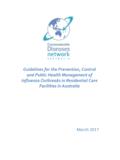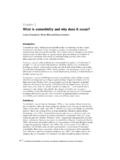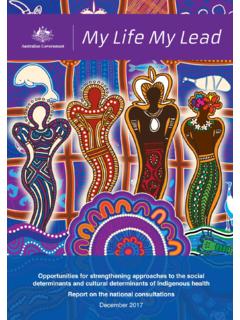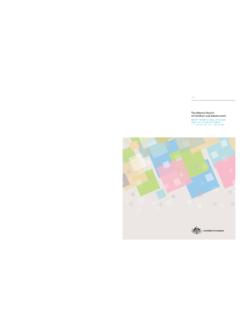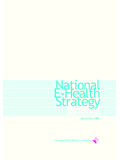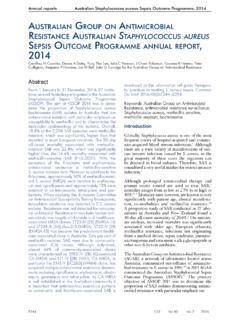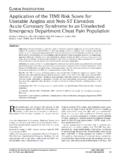Transcription of Delirium Care Pathways - Department of Health
1 Delirium care Pathways Developed on behalf of the Australian Health Ministers' Advisory Council (AHMAC) by the AHMAC Health care of Older Australians Standing Committee 2010. Delirium Pathways ISBN: 978-1-74241-313-6. Online ISBN: 978-1-74241-314-3. Publications Number: 6770. Copyright Statements: Paper-based publications Commonwealth of Australia 2011. This work is copyright. You may reproduce the whole or part of this work in unaltered form for your own personal use or, if you are part of an organisation, for internal use within your organisation, but only if you or your organisation do not use the reproduction for any commercial purpose and retain this copyright notice and all disclaimer notices as part of that reproduction. Apart from rights to use as permitted by the Copyright Act 1968 or allowed by this copyright notice, all other rights are reserved and you are not allowed to reproduce the whole or any part of this work in any way (electronic or otherwise) without first being given the specific written permission from the Commonwealth to do so.
2 Requests and inquiries concerning reproduction and rights are to be sent to the Communications Branch, Department of Health and Ageing, GPO Box 9848, Canberra ACT 2601, or via e-mail to Internet sites Commonwealth of Australia 2011. This work is copyright. You may download, display, print and reproduce the whole or part of this work in unaltered form for your own personal use or, if you are part of an organisation, for internal use within your organisation, but only if you or your organisation do not use the reproduction for any commercial purpose and retain this copyright notice and all disclaimer notices as part of that reproduction. Apart from rights to use as permitted by the Copyright Act 1968 or allowed by this copyright notice, all other rights are reserved and you are not allowed to reproduce the whole or any part of this work in any way (electronic or otherwise) without first being given the specific written permission from the Commonwealth to do so.
3 Requests and inquiries concerning reproduction and rights are to be sent to the Communications Branch, Department of Health and Ageing, GPO Box 9848, Canberra ACT 2601, or via e-mail to Published by the Australian Government Department of Health and Ageing on behalf of AHMAC. Copies of this document can be obtained from: The HCOASC Secretariat Department of Health and Ageing MDP 408. GPO Box 9848. Canberra City ACT 2601. The HCOASC Secretariat Metropolitan Health and Aged care Services Department of Health GPO Box 4057. Melbourne VIC 3000. This document may be downloaded from the Department of Health website at Delirium care Pathways Delirium care Pathways was developed to assist in the coordination of care and to improve how older people are managed during a Delirium episode to improve care and minimise adverse outcomes.
4 This document builds upon the Clinical Practice Guidelines for the Management of Delirium in Older People to provide a blueprint that guides clinicians in the provision of care in a range of Health and aged care settings (including community care ). The three examples provided in Delirium care Pathways demonstrate different patient journeys in acute care , community care and residential care . These journeys highlight the management of Delirium in different settings and include page references to more information on assessment and management. Delirium is an important clinical condition which is often left undiagnosed or mismanaged. Delirium care Pathways will assist clinicians and care givers to manage Delirium across a range of care settings.
5 Acknowledgements This resource has been developed by Associate Professor Victoria Traynor and Nicole Britten, University of Wollongong, under the management of the New South Wales Department of Health , on behalf of the Health care of Older Australians Standing Committee. 1. Preventative Strategies for Delirium Has the patient/client been identified as potentially suffering from Delirium ? Cognitive function Yes Include in care plan assessment tools Prevention pg 5. *pg 3 or ensure appropriate referral 1. Conduct baseline cognitive function Screen at regular is made assessments* intervals for change in cognitive function pg 3. Known risk Does patient/client have a cognitive factors for the impairment? Risk factor assessment No development of and management pg 4.
6 Delirium pg 4. Yes Information from 2. Determine any changes in cognitive Differential diagnosis patient/client, function (refer to Poole's carer, GP, medical Algorithm pg 6). record or facility Has there been a recent change in cognitive assessments function? No Yes Adapt care plan Delirium diagnostic 3. Assess for Delirium Consider who is tools or diagnosis consenting to care by Expert * pg 7 Does patient have a confirmed diagnosis of Delirium ? Identify and address Yes causes pg 8-10. Manage symptoms No pg 11. Pharmacological 4. Consider subclinical Delirium management pg 12. Provide supportive Does patient/client have some symptoms of care pg 13. Delirium ? Yes Prevent complications pg 5. No Monitor resolution following facility guidelines*.
7 5. Monitor and respond to any sudden Manage modifiable risk changes in cognitive function by repeating factors pg 4. pathway Educate patient and family, give facility pamphlet on pg 14. Consider use of interpreter Refer to advanced care plan * People to use service/facility preferred diagnostic and assessment tools or other relevant material. Adapted from: Clinical Epidemiology and Health Services Evaluation Unit 2006, Clinical Practice Guidelines for the 2. Management of Delirium in Older People, Victorian Government Department of Human Services, Melbourne, Victoria Cognitive Assessment Screening for Delirium : the process involved Repeat Cognitive Function In all settings when: Sudden change in behaviour or cognition If normal, or Abrupt decline Decline in score Suspect Delirium Baseline Cognitive no change in ADL performance by 2 or more Function Assessment Formal diagnosis using from previous Sudden deterioration in the points (if using Assess cognitive function MMSE, AMT) a tool and/or assessment person's condition may involve use of tool Notify expert in Delirium In community and residential diagnosis nurse, such as MMSE or AMT.
8 care when: Or if high medical staff or general on admission to Health care setting Resident or client at higher level of practioner risk of developing Delirium , suspicion such as on return from hospital admission; or when acutely unwell In high risk hospital settings: As part of screening process repeat frequently (eg. daily). If abnormal cognitive function OR. change from previous assessment OR high level of suspicion that the person has Delirium Adapted from: Clinical Epidemiology and Health Services Evaluation Unit 2006, Clinical Practice Guidelines for the Management of Delirium in Older People, Victorian Government Department of Human Services, Melbourne, Victoria. 3. Risk Factors Risk factors according to the Health care setting Health care setting Hospital intensive Hospital surgical Residential care and care units, aged care wards in particular Community care wards, and neurology orthopaedic, cardiac (no published wards and neurosurgery high level evidence).
9 (based on published wards high level evidence*) (based on published high level evidence*). Risk factors Pre-existing cognitive Pre-existing cognitive Pre-existing cognitive impairment including impairment including impairment including dementia dementia dementia Severe medical illness Severe medical illness Illness / infection Age 70 years Age 70 years Age 70 years Visual impairment Visual impairment Visual impairment Depression Depression Depression Abnormal sodium Abnormal sodium Abnormal serum Use of indwelling Use of indwelling sodium catheter catheter Use of indwelling Use of physical Use of physical catheter restraints restraints Use of physical Adding three or more Adding three or more restraints medications during medications during Multiple medication hospitalisation hospitalisation use Exposure to pethidine Alcohol
10 Related Health Exposure concerns to benzodiazepine Exposure History of Delirium to benzodiazepine Return from Alcohol related Health hospitalisation concerns Hearing impairment Exposure to narcotic analgesics preoperatively * This list of risk factors has been collated from both risk factor and risk prediction model studies. Adapted from: Clinical Epidemiology and Health Services Evaluation Unit 2006, Clinical Practice Guidelines for the Management of Delirium in Older People, Victorian Government Department of Human Services, Melbourne, Victoria. 4. Strategies to Prevent Delirium Strategies to prevent Delirium Environmental Strategies Clinical Practice Strategies Lighting appropriate to time of day windows Encourage/assist with eating and drinking with a view to outside, curtains and blinds open to ensure adequate intake during the day, and minimal lighting at night may Ensure that patients who usually wear hearing reduce disorientation and visual aids are assisted to use them Provision of single room reduces the Regulation of bowel function avoid disturbance caused by staff attending other constipation patients in the same room Encourage and assist with regular mobilisation Quiet environment especially at rest times noise reduction strategies (eg.)
